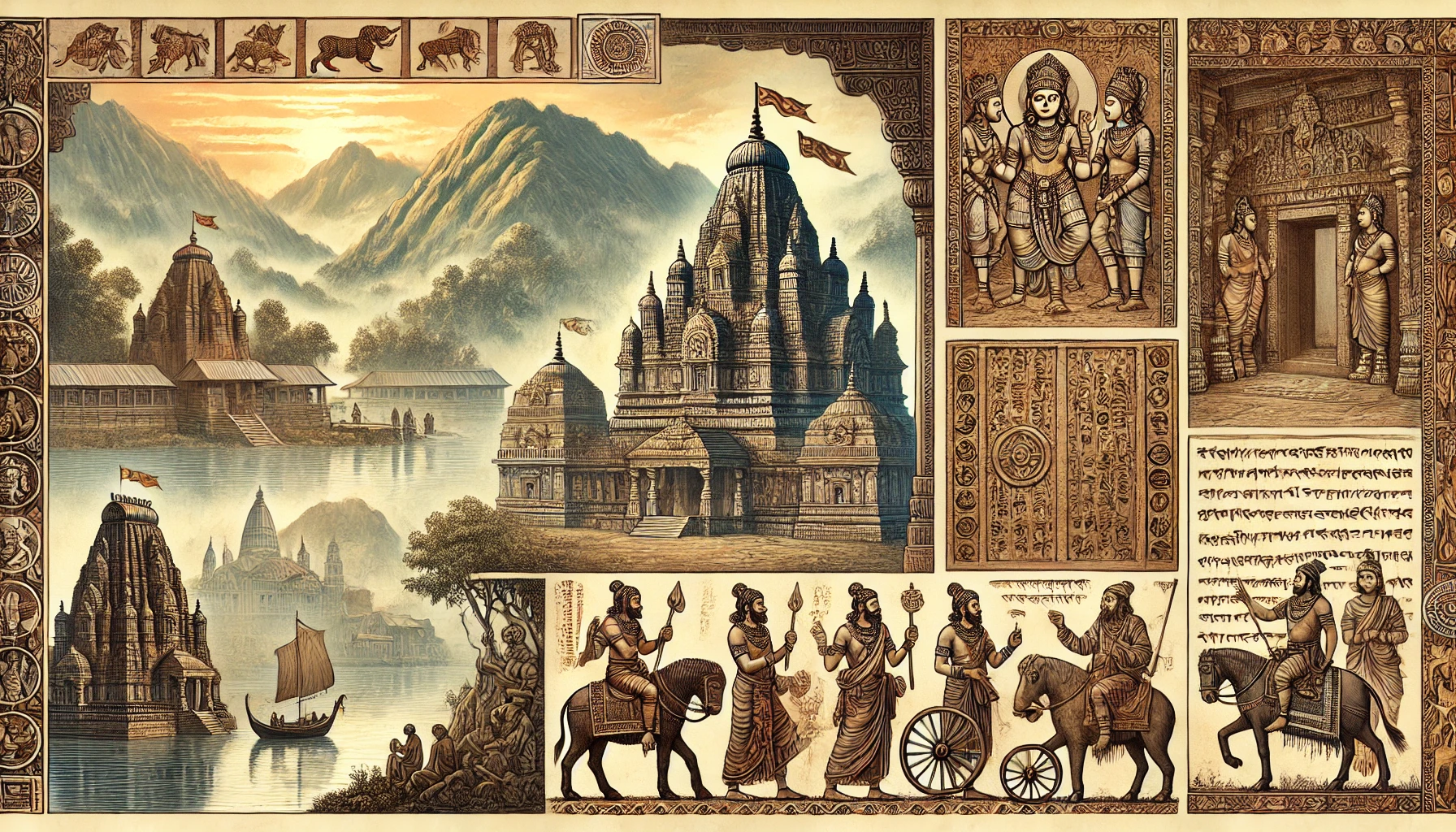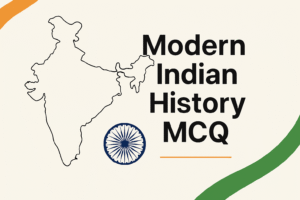History of Assam MCQs
Assam, nestled in northeastern India, boasts a rich history that underscores its cultural diversity and significance. Historically known as Kamarupa, the ancient name of Assam symbolizes its prominent role in early Indian civilizations. The state's capital, Guwahati, serves as a modern-day gateway, blending Assam's ancient heritage with its ongoing development. The history of Assam dates back to its first recorded dynasty, marking its emergence as a unique political entity in the region. Exploring Assam's ancient name, Kamarupa, and its historical background provides valuable insights into its importance within Indian history, making it an essential topic for students and enthusiasts studying History of Assam MCQs for exams.
1. What was the ancient name of Assam that translates to “the form of desire”?
A. Pragjyotisha
B. Kamarupa
C. Ahom
D. Varman
Show Answer
B. Kamarupa
2. Which dynasty is considered the earliest historical dynasty in Assam?
A. Palas
B. Varmans
C. Kamarupa dynasty
D. Mlechchhas
Show Answer
C. Kamarupa dynasty
3. Who was the founder of the Ahom dynasty?
A. Sukapha
B. Rudra Singha
C. Chandra Kumar
D. Gaurinath
Show Answer
A. Sukapha
4. Which river served as a vital trade artery in Assam's history?
A. Brahmaputra River
B. Ganges River
C. Yamuna River
D. Barak River
Show Answer
A. Brahmaputra River
5. Under which dynasty did Assam experience remarkable growth in art and architecture?
A. Kamarupa dynasty
B. Ahom dynasty
C. Pala dynasty
D. Mlechchhas
Show Answer
A. Kamarupa dynasty
6. The famous Kamakhya Temple in Assam is dedicated to which deity?
A. Shiva
B. Durga
C. Kamadeva
D. Vishnu
Show Answer
C. Kamadeva
7. Which battle marked the beginning of Ahom's decline?
A. Battle of Saraighat
B. Battle of Itakhuli
C. Battle of Mukti
D. Battle of Sattras
Show Answer
B. Battle of Itakhuli
8. The first British political agent in Assam was?
A. Captain Welsh
B. Lieutenant Munro
C. Major G.M. O’Donnell
D. Captain Lachlan Macpherson
Show Answer
A. Captain Welsh
9. What was the primary source of income in ancient Assam?
A. Agriculture
B. Trade
C. Mining
D. Fishing
Show Answer
A. Agriculture
10. Which festival is celebrated to mark the harvest season in Assam?
A. Bihu
B. Bohag
C. Magh Bihu
D. Rongali Bihu
Show Answer
D. Rongali Bihu
11. Who was the last king of the Ahom dynasty?
A. Rudra Singha
B. Purandar Singha
C. Chandra Kanta Singha
D. Gaurinath Singha
Show Answer
C. Chandra Kanta Singha
12. Which Assamese literary figure is known for his works on the history of Assam?
A. Bhupen Hazarika
B. Lakhminath Bezbaroa
C. Jyoti Prasad Agarwala
D. Hiren Gohain
Show Answer
B. Lakhminath Bezbaroa
13. What was the significance of the Sattras in Assam?
A. Places for trade
B. Centers of religious learning
C. Forts for defense
D. Agricultural hubs
Show Answer
B. Centers of religious learning
14. Who led the anti-British movement in Assam during the 1857 uprising?
A. Maniram Dewan
B. Piyali Phukan
C. Rudra Singha
D. Gopinath Bordoloi
Show Answer
A. Maniram Dewan
15. Which Assamese king is famous for his administrative reforms?
A. Rudra Singha
B. Pramatta Singha
C. Sukapha
D. Gaurinath
Show Answer
A. Rudra Singha
16. The Borahi festival is associated with which community in Assam?
A. Bodos
B. Ahoms
C. Rabhas
D. Mishings
Show Answer
C. Rabhas
17. The term ‘Sanskritization' in Assam is often linked to which aspect?
A. Economic development
B. Cultural integration
C. Political power
D. Agricultural innovation
Show Answer
B. Cultural integration
18. Who is known as the ‘father of Assamese literature'?
A. Rupkonwar Jyoti Prasad Agarwala
B. Srimanta Sankardev
C. Hiren Gohain
D. Bhupen Hazarika
Show Answer
B. Srimanta Sankardev
19. Which ancient text provides information about the early history of Assam?
A. Mahabharata
B. Puranas
C. Ramayana
D. Arthashastra
Show Answer
B. Puranas
20. The Ahom kingdom was founded in which century?
A. 12th century
B. 13th century
C. 14th century
D. 15th century
Show Answer
B. 13th century
21. What is the significance of the Treaty of Yandabo?
A. End of the First Anglo-Burmese War
B. Establishment of British rule
C. Independence of Assam
D. Formation of the Ahom dynasty
Show Answer
A. End of the First Anglo-Burmese War
22. Which king is credited with establishing the capital of the Ahom kingdom at Jorhat?
A. Rudra Singha
B. Sukapha
C. Chandra Kanta Singha
D. Laluk Sola
Show Answer
D. Laluk Sola
23. The first Assamese newspaper was published in which year?
A. 1820
B. 1846
C. 1863
D. 1900
Show Answer
B. 1846
24. What is the significance of the Assam Accord of 1985?
A. It granted statehood to Assam
B. It resolved the issues of illegal immigration
C. It provided financial aid for development
D. It established a separate council for Assam
Show Answer
B. It resolved the issues of illegal immigration
25. The Battle of Saraighat was fought in which year?
A. 1671
B. 1682
C. 1706
D. 1714
Show Answer
A. 1671
26. Which city is known as the cultural capital of Assam?
A. Guwahati
B. Dibrugarh
C. Tezpur
D. Jorhat
Show Answer
A. Guwahati
27. Who was the first Assamese to graduate from Calcutta University?
A. Anandaram Dhekial Phukan
B. Suresh Chandra Choudhury
C. Gopinath Bordoloi
D. A. M. Choudhury
Show Answer
A. Anandaram Dhekial Phukan
28. Which movement aimed at the socio-economic upliftment of the people of Assam?
A. Assam Agitation
B. Khilafat Movement
C. Quit India Movement
D. Swadeshi Movement
Show Answer
A. Assam Agitation
29. Which tea garden is considered the oldest in Assam?
A. Jorhat Tea Estate
B. Liza Tea Estate
C. Chabua Tea Estate
D. Assam Tea Estate
Show Answer
C. Chabua Tea Estate
30. Who wrote the famous Assamese book “Buranji”?
A. Hemchandra Barua
B. Radhika Mohan Gohain
C. Lakshminath Bezbaroa
D. Jagannath Barua
Show Answer
A. Hemchandra Barua
31. Which community is primarily associated with the Bihu festival?
A. Bodos
B. Ahoms
C. Mishings
D. Kacharis
Show Answer
B. Ahoms
32. Who is the author of the “Assamese Dictionary”?
A. S. K. Bhattacharya
B. N. L. Baruah
C. B. R. Chaudhary
D. S. N. Dutta
Show Answer
B. N. L. Baruah
33. Which festival is celebrated to honor the arrival of the new year in Assam?
A. Bihu
B. Rongali Bihu
C. Bohag Bihu
D. Magh Bihu
Show Answer
C. Bohag Bihu
34. What is the primary language spoken in Assam?
A. Hindi
B. Bengali
C. Assamese
D. Bodo
Show Answer
C. Assamese
35. The Sadiya region in Assam is famous for which resource?
A. Tea
B. Oil
C. Rice
D. Timber
Show Answer
B. Oil
36. Which Assamese dish is made from fermented bamboo shoots?
A. Khar
B. Fish Tenga
C. Pitha
D. Aloo Pitika
Show Answer
A. Khar
37. The ancient city of Pragjyotishpura is located near which modern city?
A. Dispur
B. Guwahati
C. Tezpur
D. Jorhat
Show Answer
B. Guwahati
38. Which Assamese folk dance is performed during the Bihu festival?
A. Sattriya
B. Bihu dance
C. Jhumur
D. Dhuliya
Show Answer
B. Bihu dance
39. Which institution was established to promote Assamese literature and culture?
A. Sahitya Akademi
B. Assam Sahitya Sabha
C. K.K. Handique State Open University
D. Gauhati University
Show Answer
B. Assam Sahitya Sabha
40. Who is known as the “nightingale of Assam”?
A. Lata Mangeshkar
B. Bhupen Hazarika
C. Zubeen Garg
D. Jayanta Hazarika
Show Answer
B. Bhupen Hazarika
41. The Brahmaputra River is known by what name in Tibet?
A. Yarlung Tsangpo
B. Indus
C. Ganges
D. Mekong
Show Answer
A. Yarlung Tsangpo
42. Which freedom fighter from Assam played a key role in the Indian National Congress?
A. Gopinath Bordoloi
B. Maniram Dewan
C. Bhupen Hazarika
D. Kumudini Devi
Show Answer
A. Gopinath Bordoloi
43. The festival of Bihu is primarily associated with which agricultural activity?
A. Sowing
B. Harvesting
C. Planting
D. Weeding
Show Answer
B. Harvesting
44. Which major wildlife sanctuary in Assam is a UNESCO World Heritage Site?
A. Kaziranga National Park
B. Manas National Park
C. Nameri National Park
D. Pobitora Wildlife Sanctuary
Show Answer
A. Kaziranga National Park
45. The Ahom dynasty ruled Assam for how many years?
A. 500
B. 600
C. 700
D. 800
Show Answer
C. 700
46. Which monument is a symbol of Assamese culture?
A. Kamakhya Temple
B. Sivasagar Sivadol
C. Talatal Ghar
D. Rang Ghar
Show Answer
D. Rang Ghar
47. Who is the founder of the Assamese film industry?
A. Jyoti Prasad Agarwala
B. Phani Sarma
C. Bhabendra Nath Saikia
D. Bhupen Hazarika
Show Answer
A. Jyoti Prasad Agarwala
48. The traditional dress of Assamese women is known as what?
A. Saree
B. Mekhela Chador
C. Salwar Kameez
D. Lehenga
Show Answer
B. Mekhela Chador
49. What is the primary occupation of the people of Assam?
A. Agriculture
B. Industry
C. Services
D. Handicrafts
Show Answer
A. Agriculture
50. Which city in Assam is known for its silk industry?
A. Tezpur
B. Sualkuchi
C. Dibrugarh
D. Jorhat
Show Answer
B. Sualkuchi
The formation of Assam as a recognized state stems from a rich tapestry of historical events and cultural influences. This journey through a brief Assam's history showcases the evolution of a land once known as Pragjyotisha, celebrating the legacy of ancient Assam. As students explore their Assam assignment, they uncover the stories of its past, helping to understand why this region holds a special place in the heart of India. Whether it is through paragraphs on Assam, history of assam mcqs or detailed research, the state's history continues to inspire and inform its people today.







